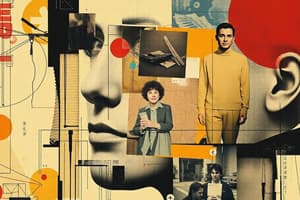Podcast
Questions and Answers
According to the James-Lange theory of emotion, how are emotions generated?
According to the James-Lange theory of emotion, how are emotions generated?
- As a result of cognitive evaluations of events
- As a result of social interactions
- As a result of physiological reactions to events (correct)
- As a result of genetic predispositions
What does the Cannon-Bard theory propose about emotional responses?
What does the Cannon-Bard theory propose about emotional responses?
- Emotional responses are solely products of physical states
- Emotional responses occur simultaneously with physiological reactions (correct)
- Emotional responses occur after physiological reactions
- Emotional responses are independent of physiological reactions
How did Walter Cannon's view differ from the James-Lange theory of emotion?
How did Walter Cannon's view differ from the James-Lange theory of emotion?
- He disagreed with the idea that physiological reactions are linked to emotions
- He disagreed with the idea that emotions occur as a result of physiological reactions
- He disagreed with the idea that emotional responses are solely products of physical states (correct)
- He disagreed with the idea that emotional responses occur simultaneously with physiological reactions
According to the Cannon-Bard theory, can people experience physiological reactions linked to emotions without actually feeling those emotions?
According to the Cannon-Bard theory, can people experience physiological reactions linked to emotions without actually feeling those emotions?
What did Phillip Bard's work contribute to the Cannon-Bard theory of emotion?
What did Phillip Bard's work contribute to the Cannon-Bard theory of emotion?
Flashcards are hidden until you start studying
Study Notes
James-Lange Theory of Emotion
- Emotions are generated by physiological responses to stimuli; the body reacts first and the mind recognizes the emotion later.
- For example, seeing a bear may trigger a racing heart, and the awareness of this physiological change leads to the experience of fear.
Cannon-Bard Theory of Emotion
- Proposes that physiological responses and emotional experiences occur simultaneously rather than sequentially.
- Both emotional responses and physiological changes are activated by the brain at the same time after the perception of a stimulus.
Differences between Cannon and James-Lange Theories
- Walter Cannon disagreed with the James-Lange theory's emphasis on a linear process; he believed that the experience of emotion and physical reaction could happen concurrently.
- Cannon argued that emotions could occur without the direct influence of physiological responses, highlighting a more complex interplay between emotion and bodily reactions.
Physiological Reactions without Emotion
- According to the Cannon-Bard theory, it is possible to have physiological reactions that are linked to emotions without actually experiencing those emotions.
- This indicates a distinction between the bodily response and the conscious feeling of an emotion.
Contribution of Phillip Bard
- Phillip Bard's work expanded the Cannon-Bard theory by elucidating the role of brain structures in emotional processing.
- His research focused on the physiological aspects of emotional reactions and supported the idea that emotions trigger bodily responses simultaneously.
Studying That Suits You
Use AI to generate personalized quizzes and flashcards to suit your learning preferences.




